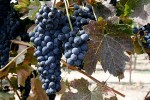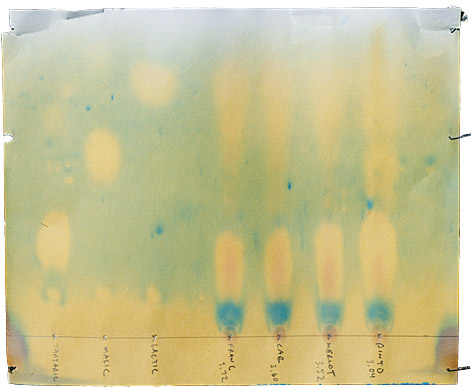Archive for the 'Fermentation' Category
Syrah begins its journey
 Yesterday morning there were the faintest signs of life: the odd bubble here and there, the islands of grape skins slightly more pronounced than before (or were they?). Now the stuff’s going full throttle, right up to the rim of the fermenter.
Yesterday morning there were the faintest signs of life: the odd bubble here and there, the islands of grape skins slightly more pronounced than before (or were they?). Now the stuff’s going full throttle, right up to the rim of the fermenter.
The syrah came in with pretty nice numbers, spot-on sugars and pretty good pH. I’ve already added a dash of acid to bring that pH down into more comfortable territory, but all the building blocks are already there: the fruit tasted at perfect ripeness out in the field — maybe the most spot-on I’ve ever tasted in our winemaking — and it hasn’t changed in the winery, either. This looks to be a stellar syrah year if we don’t screw it up.
For fun, to increase flavor for what remained, and to sneak a little more space into the fermenter, I also bled out 10 gallons of syrah juice 24 hours after crush — a technique which also the traditional way to make rosé. I see now I should have done it maybe 3-4 hours afterwards, however, since the color is more garnet than rose, but if we can ride its fermentation to the ground without crashing, that should also make it a mighty flavorful summer quaffer. It’s currently a little stinky (something David and Amy of Westrey warned me about), but I’ll hit it with some nutrient and if that doesn’t improve matters, a little copper should have it seeing things our way.
But man, you should smell it: there’s a rich, deep sweetness to the must (since it’s only just begun to convert sugar to alcohol), laced with smokiness and a whiff of leather. Can’t wait to see it at press in a week or so.
No commentsFermentation has begun
This morning, somewhere deep in the darkness of the Merlot, the effervescent joy that is fermentation officially began. It was easy to miss, but when my wife peeked under the fermenter cover, she noticed that most of the liquid formerly pooling around the skins had disappeared (fermentation pushes the grape skins, or “cap” to the surface). And sure enough, there were a few tell-tale pops of CO2 when we got closer.
As the nature writer David Rains Wallace said, “fermentation may have been a greater discovery than fire.” Indeed, over the next few weeks, Bacchus will take Prometheus to school. Ladies and gentlemen, here we go!
No commentsWinehenge
In ancient times, before history like even started, a totally ancient race of dudes used dry ice to delay fermentation and increase the exposure of skins to juice. This is, like, their story?
No comments2007 Chroma results
 With fresh reference samples of some acids to work with, I put all four wines through paper chromatography yesterday [what the heck is “paper cro-magni-wha…?”: more background here]. Bask in the aurora borealitic results above.
With fresh reference samples of some acids to work with, I put all four wines through paper chromatography yesterday [what the heck is “paper cro-magni-wha…?”: more background here]. Bask in the aurora borealitic results above.
To the left, along the baseline and on top of those tiny X’s, I placed drops of tartaric, malic and lactic acid, spaced about an inch apart. You’ll note that directly above them there are balloon-like blobs, some closer to the baseline, others closer to the top of the page. If a wine has any of those acids in it, we’d expect to see a blob about the same distance up the page above its X. Crude? Yes. Beautiful? Oh, yeah.
So take a look at the blobs to the right, above drops of the Franc, Cab, Merlot and Pinto. Drawing a horizontal line from the reference blobs on the left, you can see that all of our wines have tartaric acid (not surprisingly), and all have lactic acid. That the Franc, Cab and Merlot don’t have a blob at the malic latitude suggests that all the malic acid in those wines has been converted to lactic acid, so we can assume that malolactic fermentation has finished. Or, in non-science speak, these wines are done fermenting and are more or less safe to bottle without risk of further CO2 bubble production, popping corks down the line and embarrassing Garagistes at parties.
On the far right, however, the Pinto does show some kind of blob at the malic level, though it’s not especially distinct. I took the pH of all our wines prior to running the test (you can see those numbers next to the names), and the Pinto was just a hair above 3, which is pretty acidic (the typical range of wine hits between 3.3 and 3.6). So my guess would be that that much acid has inhibited malolactic fermentation, slowing its progress through this wine. That said, I remember the Pinto tasting great (and not “acidic”), so I’m not sure what to make of or do with this result. Is malo stuck, or simply taking its time? Dunno.
In any case, the reason I ran the test in the first place is for the Franc, whose results indicate malolactic is over and we can therefore trust the acid numbers we got earlier. So in the next day or so, I’ll be adding SO2 and some acid to try to perk up our old friend.
1 commentFerment Nutrients
The additives that proved so successful this year:
Recipe
10 gal. water, warm
25 lbs. sugar
115 g tartaric acid
80 g yeast nutrient
40 g diamonium phosphate (DAP)
05 g calcium citrate
Makes 12 gal total or scale as needed. Water temperature between 70F and 90F will make the yeast feel welcome and helps the sugar dissolve. Yeast nutrient is nutritional yeast, the same as that sold for humans at the grocery store. Diamonium phosphate is a nitrogen fertilizer. Some yeasts need more than others but a little extra is better than not enough. The tartaric acid could be another acid, even lemon juice or an acid blend. Yeast is happy in an acidic environment and most bacteria are not. If for red wine the acid addition would be 230 g to give the correct acidity in the finished beverage. Calcium is needed for yeast reproduction. If the water has less than 15 ppm calcium you need to add some. You can also use calcium carbonate (shells, antacid) or calcium sulfate (plaster of paris).
General formula in grams per liter:
1000 water
300 sugar
3 tartaric acid (6 for wine)
2 yeast nutrient
1 DAP
.1 calcium citrate
Makes 1.2 liter
3 commentsMerlot and Cab safely to bed
 Last weekend we pressed the Cabernet to glad cries: the stuff tasted positively fantastic. Deep, resonant fruit accentuated by a high-def backbone of acid and tannin. Delicious. Can’t wait to see how it matures and fleshes out in the barrel, but my guess is that we won’t have too many votes to blend this one entirely away.
Last weekend we pressed the Cabernet to glad cries: the stuff tasted positively fantastic. Deep, resonant fruit accentuated by a high-def backbone of acid and tannin. Delicious. Can’t wait to see how it matures and fleshes out in the barrel, but my guess is that we won’t have too many votes to blend this one entirely away.
For the next few months, this baby will hang its hat in a one-year-old Remond Allier MT. Unlike previous years, we’re going to try to keep the wines (Cab, Franc, Merlot) in the same barrel, rather than racking between barrels more or less indiscriminately. With luck, we’ll get more of a sense of what these barrels do to a wine (though of course, different varietals in different barrels will make cross-comparison impossible).
We also pressed the Merlot the week before. There’s a line in Shakespeare’s The Winter’s Tale where someone advises a homely shepherdess comically convinced of her beauty, “Sell when you can. You are not for all markets.” That’s a bit like the Merlot, at least for the moment. At first blush, it’s a lovely wine to smell, but ultimately, that may be its most comely attribute. There’s decent structure (mostly from acid, as opposed to tannin), and nice fruit, but at least for me, it lost interest and went back to filing its nails somewhere around mid palate. Hopefully that will improve with some time in the fine, French oak pied-Ã -terre we got for it (a Gillet 2006 Allier MT).
Pics below the fold…
3 comments